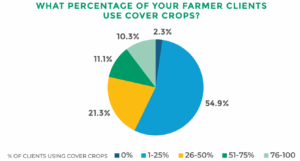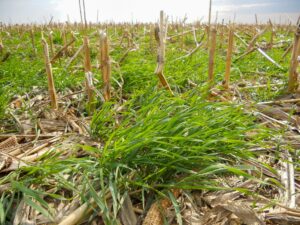By: 4R Plus
May 2023

If you drove past snow-covered fields this past winter, there’s a chance you saw a lot of dirty snowbanks. This “snirt” – a mix of snow and dirt – is a stark image, but in terms of erosion, Rick Cruse, Ph.D., agronomy professor at Iowa State University and director of the Iowa Water Center, says it pales in comparison to other forms of erosion.
“Wind erosion is very real. In Iowa, its impact is about 1 ton or less of soil lost per acre each year,” says Cruse. “Iowa fields lose an additional 5.5 to 6.0 tons of soil per acre from water erosion annually.”
Erosion is already impacting crop yields
“Take a look at a yield map of any rain-fed agricultural field in Iowa and you’ll see the impact of erosion, especially during hot, dry summers,” Cruse explains. Estimates show roughly one-third of the Corn Belt is currently devoid of topsoil due to a combination of water, wind and tillage erosion. “Those areas have compromised yields,” Cruse says.
The Daily Erosion Project, which is co-led by Cruse, estimates soil erosion loss across multiple Midwestern states. The project found that larger yields decrease soil erosion because more plant residue occurs with high yields and increases soil protection. “If there are hot, dry conditions that reduce yields followed by a heavy rain event, there’s less biomass to protect the soil from being washed away. Unfortunately, we’ve seen more of these types of weather patterns in recent years,” says Cruse.

The frequency of these extreme weather events in concentrated areas is also affecting soil erosion, Cruse says. “The impact of these localized events doesn’t look so bad when they’re averaged out across the state, but the soil erosion happening in the fields in those areas is major.
“Yields and biomass short-changed by lengthier droughts in the future will likely also lead to more soil loss from wind erosion,” Cruse warns.
Protect crops from erosion with 4R Plus practices
To mitigate soil loss, Cruse stresses the importance of keeping soil covered. He says using 4R Plus practices like cover crops, no-till, prairie strips and terraces can help with erosion, but he cautions not all of them help to the same degree.

“Imagine a farm’s soil is covered in carpet. Like carpet, cover crops keep the ground covered in the ‘off-season’ when the soil would otherwise be exposed,” says Cruse. “The velocity of a raindrop can easily detach soil particles from the ground and wash them away, but a cover crop absorbs some of the impact and keeps the soil in place.” He adds the cover crop’s living root system improves soil biology and helps with water infiltration.
“Erosion from tillage can be just as damaging as water erosion,” says Cruse. “No-till leaves residue undisturbed, which protects the soil, but only if it’s managed properly.”
No-till helps slow water down, but Cruse emphasizes the need to be careful not to wipe out grassed waterways. “As long as it’s managed properly, no-till can effectively reduce erosion.”
Prairie strips and terraces slow the flow of water, which controls sedimentation and keeps the soil from leaving the field. Cruse says, “Terraces can also prevent deep cuts in the field, called ephemeral gullies, from forming.
“It will take many decades to reverse the damage of soil erosion to date,” continues Cruse. “However, farmers who keep the ground covered insulate themselves from further soil loss and ensure there’s rich soil for future generations to farm.



